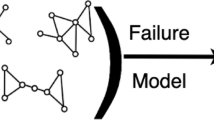Abstract
In this paper we assess the vulnerability of different synthetic complex networks by measuring the traffic performance in presence of intentional nodes and edge attacks. We choose which nodes or edges would be attacked by using several centrality measures, such as: degree, eigenvector and betweenness centrality. In order to obtain some information about the vulnerability of the four different complex networks (random, small world, scale-free and random geometric) we analyze the throughput of these networks when the nodes or the edges are attacked using some of the above mentioned strategies. When attack happens, the bandwidth is reallocated among the flows, which affects the traffic utility. One of the obtained results shows that the scale-free network gives the best flow performance and then comes random networks, small world, and the poorest performance is given by the random geometric networks. This changes dramatically after removing some of the nodes (or edges), giving the biggest performance drop to random and scale-free networks and smallest to random geometric and small world networks.
Access this chapter
Tax calculation will be finalised at checkout
Purchases are for personal use only
Preview
Unable to display preview. Download preview PDF.
Similar content being viewed by others
References
Erdős, P., Rényi, A.: On the evolution of random graphs. Publ. Math. Inst. Hung. Acad. Sci. 5, 17–61 (1960)
Barabási, A.-L., Albert, R.: Emergence of scaling in random networks. Science 286, 509–512 (1999)
Penrose, M.: Random Geometric Graphs. Oxford University Press, New York (2004)
Newman, M.E.J.: The structure and function of complex networks. SIAM Rev. 45, 167–256 (2003)
Dezso, Z., Barabási, A.-L.: Halting viruses in scale-free networks. Phys. Rev. E 65, 055103 (2002)
Latora, V., Marchiori, M.: How the science of complex networks can help developing strategies against terrorism. Chaos, Solitons and Fractals 20, 69–75 (2004)
Nekovee, M., et al.: Theory of rumour spreading in complex social networks. Physica A 374, 457–470 (2007)
Kempe, D., Kleinberg, J.M., Tardos, E.: Maximizing the spread of influence through a social network. In: ACM SIGKDD international conference on Knowledge discovery and data mining (2003)
Checco, P., Biey, M., Vattay, G., Kocarev, L.: Complex network topologies and synchronization. In: Proc. ISCAS 2006, Kos, Greece, May 2006, pp. 2641–2644 (2006)
Crucitti, P., Latora, V., Marchiori, M.: Model for cascading failures in complex networks. Phys. Rev. E 69, 045104(R) (2004)
Guimera, R., Diaz-Guilera, A., Vega-Radondo, F., Cabrales, A., Arenas, A.: Optimal network topologies for local search with congestion. Phys. Rev. Lett. 89, 248701–248704 (2002)
Boccaletti, S., Latora, V., Moreno, Y., Chavez, M., Hwang, D.-U.: Complex networks: Structure and dynamics. Phys. Rep. 424, 175–308 (2006)
Motter, A.E., Lai, Y.-C.: Cascade-based attacks on complex networks. Phys. Rev. E 66, 065102(R) (2002)
Holme, P., Kim, B.J., Yoon, C.N., Han, S.K.: Attack vulnerability of complex networks. Phys. Rev. E 65, 056109 (2002)
Mirchev, M., Filiposka, S., Trajkovski, N., Trajanov, D.: Network utility maximization in ad hoc networks with different communication patterns. In: ETAI 2009, Ohrid, Macedonia (2009)
Kelly, F.P., Maulloo, A.K., Tan, D.K.H.: Rate control in communication networks: shadow prices, proportional fairness and stability. J. Optical Research Society 49, 237–252 (1998)
Kunniyur, S., Srikant, R.: End-to-end congestion control schemes: Utility functions, random losses and ECN marks. IEEE/ACM Transactions on networking 11(5), 689–702 (2003)
Freeman, L.: Centrality in social networks: Conceptual clarification. Social Networks 1(3), 215–239 (1979)
Nieminen, J.: On the centrality in a graph. Scandinavian Journal of Psychology 15(1), 332–336 (1974)
Bonacich, P.: Factoring and weighting approaches to status scores and clique identification. Journal of Mathematical Sociology 2(1), 113–120 (1972)
Larry, P., Sergey, B., Motwani, R., et al.: The PageRank citation ranking: Bringing order to the web (1998), http://citeseer.nj.nec.com/page98pagerank.html [04.06. 2003]
Karonski, M., Rucinski, A.: The Origins of the Theory of Random Graphs. The Mathematics of Paul Erdos. Springer, Berlin (1997)
Amaral, L.A.N., Scala, A., Barthelemy, M., Stanley, H.E.: Classes of small-world networks. PNAS 97, 11149–11152
Barabasi, A.L.: Linked. Penguin Group, London (May 2003)
CVX: Matlab Software for Disciplined Convex Programming, http://www.standofd.edu/~boyd/cvx
Igor, M., Filiposka, S., Gramatikov, S., Trajanov, D., Kocarev, L.: Game Theoretic Approach for Discovering Vulnerable Links in Complex Networks. In: International Joint Conferences on Computer, Information, and System Sciences, and Engineering, University of Bridgeport, USA, December 5-13 (2008)
Author information
Authors and Affiliations
Editor information
Editors and Affiliations
Rights and permissions
Copyright information
© 2010 Springer-Verlag Berlin Heidelberg
About this paper
Cite this paper
Mishkovski, I., Kojchev, R., Trajanov, D., Kocarev, L. (2010). Vulnerability Assessment of Complex Networks Based on Optimal Flow Measurements under Intentional Node and Edge Attacks. In: Davcev, D., Gómez, J.M. (eds) ICT Innovations 2009. ICT Innovations 2009. Springer, Berlin, Heidelberg. https://doi.org/10.1007/978-3-642-10781-8_18
Download citation
DOI: https://doi.org/10.1007/978-3-642-10781-8_18
Publisher Name: Springer, Berlin, Heidelberg
Print ISBN: 978-3-642-10780-1
Online ISBN: 978-3-642-10781-8
eBook Packages: EngineeringEngineering (R0)




